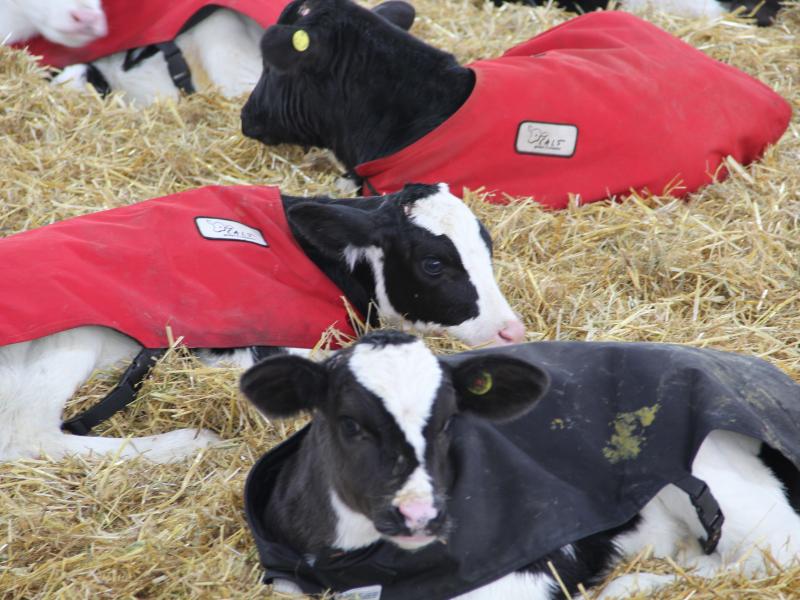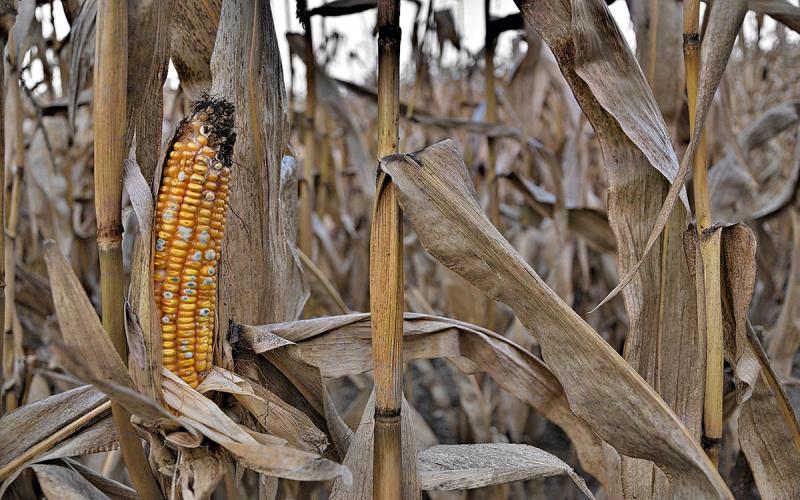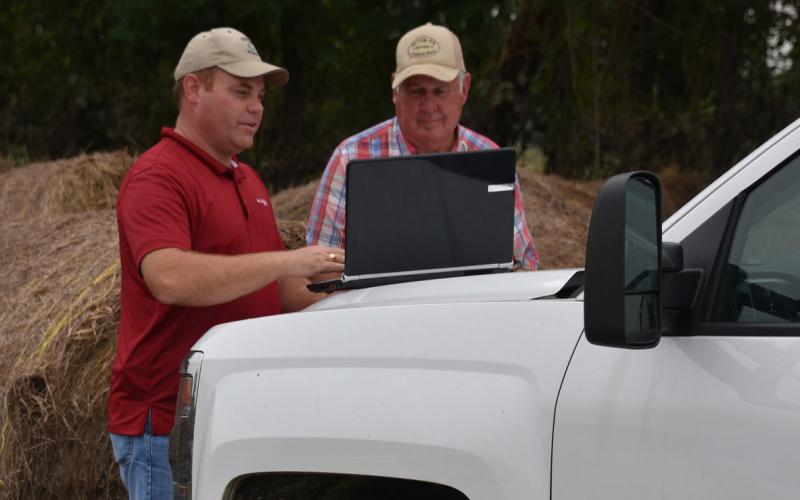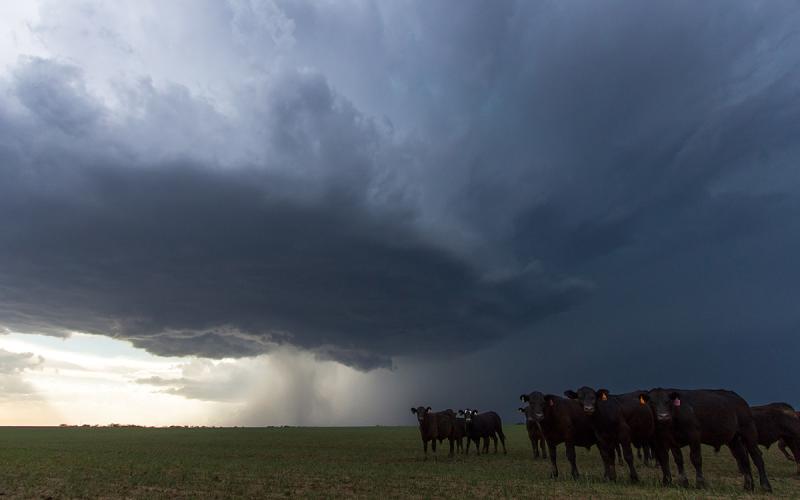Originally written by Tracey Erickson, former SDSU Extension Dairy Field Specialist.
The most critical and most expensive period of calf growth in raising dairy calves is the pre-weaning period. During this period calves are highly susceptible to cold stress with a lower critical temperature of 50°F for newborn calves and 32°F for older calves. Cold stress can result in calves turning to stored body fat to generate body heat, essentially losing weight. In addition, calves experiencing cold stress will have compromised immune systems making them more susceptible to disease.
Three main areas to focus on for winter calf care include:
- Overall nutrition and feeding requirements.
- Management.
- Calf environment.
Nutrition and Feeding
- Feed more milk or milk replacer daily if using individual bottle or pail feedings in one of three ways: 1) add a feeding or a third meal, 2) increase the volume fed by 1/3 or 3) increase the total solids fed. Producers should work with a nutritionist to make sure they are not exceeding 15% total solids in the milk replacer.
- Traditional calf milk replacer should contain a minimum of (air dry basis) 20% protein, (22 to 24% protein if it contains non-milk proteins such as soy protein or fish meal) and at least 15% fat. Fat sources in milk replacers such as milk fat, tallow, choice white grease or lard are preferred over vegetable oils, which are poorly utilized by calves. Replacers containing 15 to 20% fat are preferred, especially for calves housed in colder environments. Milk replacers containing all milk products generally are better than those containing vegetable proteins, vegetable oil, or fish proteins. If milk replacers containing non-milk protein sources are going to be fed, it is recommended not to start before 3 weeks of age. After the third week, calves should be able to better digest formulations with non-milk protein sources. Calves also can be fed mastitis/antibiotic milk if it appears wholesome and if it is not from a cow with staphylococcal and/or coliform mastitis. If calves are going to be fed discard milk, pasteurization of the milk is recommended. Milk should be fed at a minimum of 101.5°F or body temperature.
- If you are following an accelerated program you will be using a milk replacer with an increased protein content (26-28%) and a decreased fat content (15-20%).
- Addition of a commercial fat supplement to increase the energy content in your milk or milk replacer may be utilized, however, it is recommended to use products that are made to mix specifically with liquids.
- Studies now recommend that small breed calves consume 1.3 lbs. of Dry Matter (DM) with 0.3 lbs. of fat and large breed calves consume 2.0 lbs. of DM and 0.5 lbs. of fat per day in addition to calf starter and fresh water.
- Offer fresh clean water daily and during extremely cold weather it may be necessary to do so several times a day due to freezing conditions. It should be warmed to body temperature prior to feeding during cold periods. Consumption should be at the rate of 1 gallon/day for the first month and 2/gallons per day for the second month prior to weaning.
- In addition, to milk or milk replacer, give calves free access to a calf starter grain mixture a few days after birth. Calf starter should contain a minimum of 18% protein and be palatable to encourage the calf to begin eating at an early age. Additionally, there are now calf starters on the market with 22% protein content available for accelerated growth. Overfeeding total protein in the diet may lead to scouring or loose stools. Physical form of the starter is also important; coarse and/or pelleted are better than finely ground starters. By two weeks of age the calf should be eating approximately one-half pound of starter. Top quality hay should also be offered starting around weaning time. The Calves are typically weaned between 6 to 8 weeks of age but they should not be weaned unless they are consuming a minimum of 2.0 lbs. of calf starter and drinking water for at least three consecutive days.
- Utilization of electrolytes may be necessary if calves become dehydrated when ill.
Management

Calf management takes dedication and extra time, especially during cold weather. Extra labor or time will be needed for increased feedings, additional bedding, and cleaning. Calf coats requires extra time for utilization and laundering, during cold weather to help provide extra protection. Weaning calves during extreme cold conditions provides added stress to the animal and consideration should be given to delaying weaning until temperatures are less extreme.
Environment
Whether you are using individual pens, hutches, or group housing for calves there are some key principles to remember regarding young calf housing.
- Newborn calves have limited body fat reserves and a minimal hair coat. When moving newborn calves first make sure they are dry. Keep them warm by either transporting them in a trailer or covered device with clean bedding. If a wheel barrow or open bucket is used for transport putting a clean calf blanket on will with clean bedding underneath will help maintain body heat.
- Deep, dry bedding is essential. Straw is preferred, especially during the colder winter months as it allows calves to nestle down into the straw to maintain body heat better. Make sure the bedding is dry by kneeling or placing your knees on the straw for 20 seconds, if they become wet you either need to change the bedding or add more.
- Adequate ventilation that provides fresh clean air, while keeping humidity down, without allowing for drafts is essential for calf barns. Draft prevention is key to keeping calves from catching respiratory diseases.
- Calf blankets may be utilized during cold weather to help provide extra protection, however it is critical to clean the blankets between each use to minimize disease spread.
- Sanitation of bottles and equipment is key to minimize diseases being spread between calves.
In summary, taking the time to properly manage dairy calves during cold weather is critical to keeping young calves healthy and growing at adequate levels.
References:
- Anderson, K. (2014, October 25). University of Minnesota Extension. Retrieved December 15, 2014, from Dairy Extension
- Binversie, L. (2014, October 29). UW-Extension Dairy Extension Resources. Retrieved December 15, 2014, from University of Wisconsin-Extension
- Eastridge, M. L. (2014, October 1). Managing Dairy Calves and Heifers during the Winter Months - eXtension. Retrieved December 15, 2014, from eXtension.
- Garry, F. (2006). Feeding Calves in Cold Weather. Colorado State University. Retrieved December 15, 2014.


